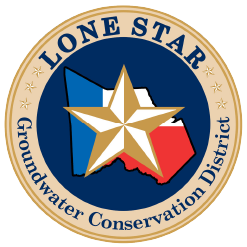Subsidence
Explore Groundwater-Level and Compaction Data in the Chicot, Evangeline and Jasper Aquifers
USGS measures groundwater levels in over 700 wells in an 11-county area annually in the Houston-Galveston area in order to develop a regional depiction of groundwater levels. The cumulative compaction in the Chicot and Evangeline aquifers are measured at 13 extensometer stations in the 11-county area.
Water-level altitude contours, wells, and compaction data have been combined in an interactive map that allows users to view annual water-level altitudes from 1977 through the present, water-level changes over time, and historical time series of compaction data.
Land subsidence is sinking of the land surface, caused by compressing the many layers of clay beneath the surface. When we pump large amounts of groundwater from the aquifers beneath us, we pull water out of the many layers of clay, which can cause the clay to compact. Some natural land subsidence also occurs over long periods of time, due to natural settling.
Subsidence can be an important issue in certain areas such as the Gulf Coast region. People who live in the lower lying coastal areas (i.e., lower elevations and flatter topography) have much more reason to be concerned with subsidence than those who reside further inland in areas of higher elevations with more topographic relief. One of the primary concerns of subsidence in the coastal regions is flooding due to storm surges associated with hurricanes, where permanent seawater inundation and periodic storm water surge can dramatically impact property.
Subsidence is known to have occurred in the southern part of Montgomery County based on monitoring and long-term surveying of land surface. Since the mid 1970’s, the USGS and the Harris-Galveston Subsidence District have conducted scientific investigations and subsidence monitoring for over 40 years. These efforts have identified and documented the susceptibility of land surface subsidence due to the production of groundwater in the Chicot and Evangeline aquifers.
The Lone Star Groundwater Conservation District in 2012 purchased six Periodically Accessible Monitors (PAMs), which are specifically designed to detect subsidence. These units operate in conjunction with the two that have been monitoring land levels in Montgomery County for more than 10 years.
Regular, precise, automated readings are taken of the elevation of the ground at locations throughout the county. The data is temporarily stored in an on-site monitor and periodically uploaded to computers at the Harris Galveston Subsidence District.
The live data from the two older PAM units may be viewed by clicking on the Subsidence Monitoring Network Map (If you have Google Earth installed on your computer, simply click on the .kml file, and Google Earth will automatically open, showing you the network map.). Lone Star GCD is working with the Subsidence District to make the newer stations available online. You can also view water levels by visiting the Lone Star Static Well Level Monitoring Network Map.
Presentations
Lone Star Groundwater Conservation District - Phase 3 Site-Specific Subsidence Investigations (December 12, 2022)
Lone Star Groundwater Conservation District - Phase 2 Subsidence Investigations (January 26, 2022)
Subsidence Study
Subsidence Study Phase 2 Final Report (as approved on May 10, 2022)
Subsidence Study Phase 2 Scope of Work (as approved on April 13, 2021)
Subsidence Study Phase 1 Final Report (as approved on August 11, 2020)
Subsidence Study Phase 1 Draft Final Report (pending Board approval on August 11, 2020)


